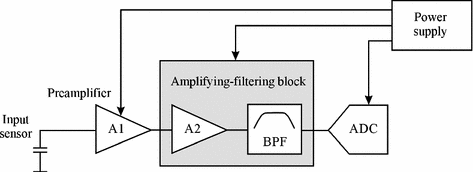
In order to show the effect of not having a small enough spot size, the field of this 20-MHz focusing transducer was measured in its geometric focal plane by a hydrophone with a 500-μm spot diameter and another with a spot size on the order of 40 μm ( Lum et al., 1996). As an example, consider a 20-MHz transducer with a diameter of 6.35 mm (2 a) and a focal length of 19 mm ( l) this case gives a value of b max=57 μm. In other words, the higher the center frequency of the transducer, the smaller the spot size has to be. In which a is the transducer radius or equivalent dimension, λ is wavelength in water, and l is the axial distance between the transducer and hydrophone. Although needle hydrophones have become primary hydrophones in many laboratories, membrane hydrophones have become more prevalent for acoustic output measurements because of their reliability and relatively flat frequency response over the range necessary for imaging transducers.

The needle hydrophone has an advantage over the membrane-style hydrophone in that it can be used for in situ exposure measurements in the body, and in many other applications where limited accessibility is a problem. While the low-frequency response is flat (between 1 and 10 MHz in the range for most diagnostic imaging transducers), it depends on the diameter of the hydrophone and is not smooth. This transducer is also a half-wave resonator. The needle hydrophone ( Lewin, 1981) is a compact broad-bandwidth device on the order of 1 mm in diameter with good directivity. Sensitivity curves for bilaminar membrane hydrophones with and without compensating external amplifiers. Note that with a matched compensated external amplifier, the overall hydrophone-amplifier response can be made flat over a nearly 30-MHz range.įigure 13.12. This resonance corresponds approximately to the one-way (receiver) frequency response shown in Figure 13.12 for 15-μm-thick bilaminar hydrophones. For the bilaminar design, which is immune to water conduction and radio frequency (RF) interference effects, two layers are used so that the center frequency is half that of one layer, or about 33 MHz. Note that the speed of sound for PVDF is about 2 mm/μs, so for a 25-μm-thick hydrophone, the center frequency is about 67 MHz.

Hydrophone transducers have a half-wave resonance frequency between 20 and 40 MHz, depending on their thickness (described in Chapter 5). The membrane is so thin that it is practically transparent to waves in the normal imaging frequency range. The membrane type consists of a thin sheet of the piezoelectric material PVDF stretched across a hoop a few centimeters in diameter and poled in its center to be piezoelectrically active in a small circular region, typically 0.2–1 mm in diameter. At 15 MHz a misalignment of only 15° coincides with a minimum and very little signal would be recorded by the hydrophone. However, multiple, well-defined minima appear in the directional response as frequency increases. At low frequencies (< 3 MHz), a hydrophone placed perpendicular to the incident waveform would experience at most a 6–8 dB reduction in signal relative to a perfectly aligned device.

The importance of considering directivity before undertaking hydrophone measurements is clearly displayed in Fig. 19.1. For this reason, care should be taken when comparing experimental directivities with Eq. membrane hydrophones – see Section 19.3.3) there may also be well-understood constructional reasons for which Eq. (1982) measured the directional response of a number of different hydrophones, and found that other analytical models involving soft- or un-baffled circular elements may be equally as valid. As will be seen later, many hydrophones are deliberately small to minimise their scattering cross-section, and this rigid baffle assumption (particularly at lower frequencies where wavelength is long) looks open to challenge. The most troubling aspect is the assumption of the circular element being in a rigid baffle of infinite extent. 19.6 is based upon a number of assumptions that may be irrelevant, or in some cases erroneous, in the context of a specific hydrophone. It is important to state that the derivation of Eq. Where k is the wavenumber and a is the radius of the circular piston.


 0 kommentar(er)
0 kommentar(er)
